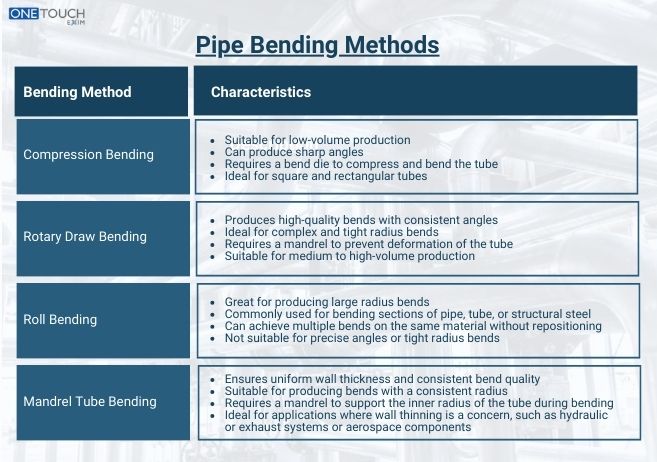Knowing the specifics of “industrial pipe bending” and “pipe rolling” is essential when it comes to Industrial Pipe Bending Techniques. These are not just catchphrases used in the industry; they are essential procedures that spur innovation in a variety of fields, including aerospace and the automobile.
Industrial pipe bending is an art that uses sophisticated equipment like CNC machines and mandrel-bending equipment. This accuracy guarantees the necessary accuracy as well as flexibility for complex projects. Because of their consequent adaptability, “industrial pipe bending” and “pipe rolling” have revolutionized a wide range of industries.
This article delves deeply into the field of industrial pipe bending, shedding light on its applications in the food processing, power plant, petrochemical processing, and construction industries. We examine its advantages as well as the difficulties faced by professionals in the modern, fast-paced industrial world. Gaining a grasp of “industrial pipe bending” and “pipe rolling” is a sensible first step if you want to improve your operations.
Different Types Of Pipe Bending Methods
Tube and pipe bending can be done in four (4) general ways, which are further divided into categories according on complexities.
- Compression Bending
- Rotary Draw Bending
- Roll Bending
- Mandrel Tube Bending
Compression Bending:-
As the name indicates, the compression bending method applies a pushing force to the pipe material to create the required deformity. One of the most basic types of pipe bending, this method is usually applied in the production of electrical conduit pipes that just need basic bending configurations.
Although this approach is not as accurate as mandrel or rotary draw bending, it is perfect for tasks where cost-effectiveness is more important than accuracy. It is crucial to remember that using this method may cause some pipe to flatten at the bend.
Examples
- This technique is frequently applied to bend railings and basic metal frames when it is not necessary for the pipe’s diameter to be precisely consistent.
- It is also widely utilized in the building of simple metalwork projects and playground equipment.
Rotary Draw Bending:-
The rotary draw will be the best bending technique if you require precise pipe diameter measurements and a superior finish. It offers a high accuracy %. Additionally, complex bending operations on different works can be replicated by draw bending machines by programming, all while maintaining accuracy and consistency. Handrails, conduit bending, trailer frames, car chassis, and roll cages are all made by rotary draw bending. For visually appealing results, the rotary draw bending application must be used with the appropriate and comprehensive tools.
Tubing components used in roll cages, railings, bicycle handlebars, and other similar machinery and structural frameworks are frequently bent using the rotary draw bending process.
Examples
- Due to the requirement for exact, constant bends, this method is frequently used to bend tubes for roll cages in race cars.
- It is also frequently used in the construction of bike frames, furniture, and structural supports.
Roll Bending:-
The ring roll bending technique works well for pipes and tubes with big circumferences. It uses hydraulically or manually adjustable benders with three-ring rolls arranged in a pyramidal pattern. Because it yields nearly homogeneous cross-sections with minimal deformation, this technique is well-liked in the industry. It is frequently used to create appliance frames, drum rolls, and other spherical objects with big diameters. In order to make spirals and continuous coils of pipe, most benders also use roll bending.
Examples
- This method is frequently used in the construction of roller coasters and other large-scale structural supports, among other industries where big pipes must be bent into curves.
- It is also frequently used in the construction of bike frames, furniture, and structural supports.
Mandrel Tube Bending:-
Very little distortion occurs in tubes or pipes when using the mandrel bending method, which yields exact results. Because of the internal support it employs during the operation, it can even handle thin materials without breaking. When the material is being formed by a bending die, a flexible mandrel is inserted within the tube shaft to stop distortion. Dairy tubing, heat exchange, and exhaust pipes are the three main applications for mandrel bending.
The mandrel’s function is to support the tube, and it is frequently employed in conjunction with various machine types in addition to the rotary draw bending machine. Even while it could cost more than a standard bending machine, it has a far shorter lead time and can be repeated without sacrificing process quality.
Examples
In order to achieve the best possible exhaust flow, exhaust pipes that need to be bent with a clear and consistent internal diameter are bent using mandrel bending, which is widely employed in the automotive sector.
Compression Bending vs Rotary Draw Bending vs Roll Bending vs Mandrel Tube Bending
| Bending Method | Characteristics |
| Compression Bending | Suitable for low-volume productionCan produce sharp angles Requires a bend die to compress and bend the tubeIdeal for square and rectangular tubes |
| Rotary Draw Bending | Produces high-quality bends with consistent anglesIdeal for complex and tight radius bendsRequires a mandrel to prevent deformation of the tubeSuitable for medium to high-volume production |
| Roll Bending | Great for producing large radius bends Commonly used for bending sections of pipe, tube, or structural steelCan achieve multiple bends on the same material without repositioningNot suitable for precise angles or tight radius bends |
| Mandrel Tube Bending | Ensures uniform wall thickness and consistent bend qualitySuitable for producing bends with a consistent radiusRequires a mandrel to support the inner radius of the tube during bendingIdeal for applications where wall thinning is a concern, such as hydraulic or exhaust systems or aerospace components |
